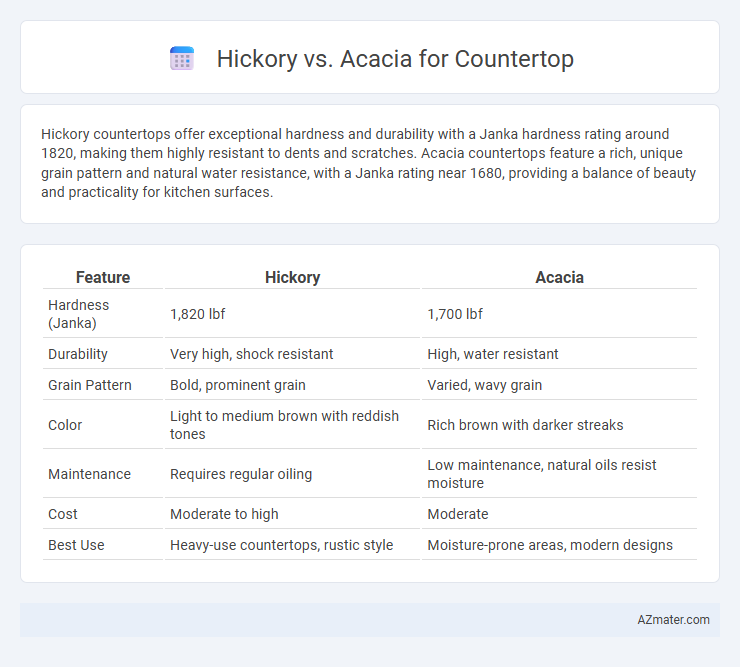Hickory countertops offer exceptional hardness and durability with a Janka hardness rating around 1820, making them highly resistant to dents and scratches. Acacia countertops feature a rich, unique grain pattern and natural water resistance, with a Janka rating near 1680, providing a balance of beauty and practicality for kitchen surfaces.
Table of Comparison
| Feature | Hickory | Acacia |
|---|---|---|
| Hardness (Janka) | 1,820 lbf | 1,700 lbf |
| Durability | Very high, shock resistant | High, water resistant |
| Grain Pattern | Bold, prominent grain | Varied, wavy grain |
| Color | Light to medium brown with reddish tones | Rich brown with darker streaks |
| Maintenance | Requires regular oiling | Low maintenance, natural oils resist moisture |
| Cost | Moderate to high | Moderate |
| Best Use | Heavy-use countertops, rustic style | Moisture-prone areas, modern designs |
Introduction: Hickory vs Acacia Countertops
Hickory countertops offer exceptional hardness and distinct grain patterns characterized by strong contrasts between light and dark streaks, making them ideal for rustic or traditional kitchen designs. Acacia countertops provide natural durability with moisture resistance and a rich, warm color palette that ranges from golden brown to deep reddish hues, enhancing contemporary and tropical aesthetics. Comparing hickory and acacia reveals differences in hardness rating, sustainability, and maintenance requirements vital for selecting the perfect countertop material.
Wood Grain and Aesthetic Appeal
Hickory countertops boast a bold, pronounced wood grain with striking color variations ranging from creamy whites to rich browns, creating a rustic yet vibrant aesthetic. Acacia features a smooth, uniform grain with warm hues of amber and reddish-brown, offering a sleek and contemporary appearance. Both woods provide distinctive visual textures, with hickory emphasizing rugged charm and acacia delivering elegant warmth.
Durability and Longevity Comparison
Hickory countertops offer exceptional hardness with a Janka rating of 1,820, making them highly resistant to dents and scratches, which contributes to their long-lasting durability in high-traffic kitchens. Acacia wood, featuring a Janka hardness of approximately 1,710, is also durable but slightly softer than hickory, requiring more care to maintain its surface integrity over time. Both woods provide excellent longevity when properly sealed, but hickory's superior hardness and dense grain structure typically result in greater resistance to wear and extended lifespan as a countertop material.
Hardness and Scratch Resistance
Hickory countertops are known for their high hardness rating of around 1,820 on the Janka scale, making them extremely durable and resistant to dents and scratches. Acacia, with a Janka hardness of approximately 1,700, offers strong scratch resistance but is slightly softer than hickory, which may result in more visible surface wear over time. Both woods provide excellent durability for countertops, but hickory's superior hardness ensures better performance in high-traffic kitchen environments.
Maintenance and Upkeep Requirements
Hickory countertops demand regular sealing and occasional sanding to maintain their durability and resist moisture damage, making them suitable for high-traffic kitchens with moderate upkeep commitment. Acacia countertops feature natural resistance to moisture and scratches, requiring less frequent sealing but benefit from routine cleaning and oiling to preserve their rich color and prevent drying or cracking. Both hardwood options necessitate prompt spill cleanup to avoid stains and ensure long-term aesthetic appeal, but Acacia offers a slightly lower maintenance profile due to its inherent hardness and natural oils.
Cost and Budget Considerations
Hickory countertops typically cost between $4 to $7 per square foot, making them a budget-friendly option compared to Acacia, which ranges from $6 to $12 per square foot due to its exotic appeal and durability. Hickory offers a competitive price point with a rugged, rustic look ideal for cost-conscious renovations, while Acacia's higher price reflects its dense grain and resistance to wear, suitable for long-term investment. Choosing between them depends on balancing immediate budget constraints with desired durability and aesthetic qualities in kitchen design.
Sustainability and Environmental Impact
Hickory countertops offer enhanced sustainability due to their rapid growth rate and wide availability, minimizing deforestation and resource depletion. Acacia, while durable and naturally resistant to moisture, often comes from slower-growing trees, which may lead to higher environmental impact if not sourced responsibly. Opting for FSC-certified hickory or reclaimed wood versions of either species ensures a lower carbon footprint and supports sustainable forestry practices.
Water and Stain Resistance
Hickory countertops offer moderate water resistance but are more prone to staining without proper sealing, requiring regular maintenance to preserve their appearance. Acacia wood exhibits higher natural water and stain resistance due to its dense grain and natural oils, making it a durable choice for countertops exposed to moisture and spills. Both woods benefit from periodic treatment with sealants, but acacia's superior resistance generally results in lower maintenance and longer-lasting durability in wet environments.
Best Applications for Each Wood Type
Hickory countertops excel in high-traffic kitchen areas due to their exceptional hardness and resistance to dents, making them ideal for chopping surfaces and heavy use. Acacia countertops offer a rich, striking grain pattern and natural water resistance, suited for decorative island tops and moisture-prone environments like bathrooms or coastal kitchens. Both woods provide durability, but Hickory is best for rugged, functional spaces while Acacia enhances aesthetic appeal with moderate durability.
Final Verdict: Choosing the Right Countertop Wood
Hickory countertops offer exceptional durability and a striking grain pattern, making them ideal for high-traffic kitchens requiring a hard-wearing surface. Acacia provides a rich, warm color with impressive water resistance, perfect for rustic or tropical-inspired designs demanding natural beauty and resilience. Selecting between hickory and acacia ultimately depends on prioritizing either superior hardness and bold texture or enhanced moisture resistance and vibrant coloration for your kitchen countertop.

Infographic: Hickory vs Acacia for Countertop
 azmater.com
azmater.com